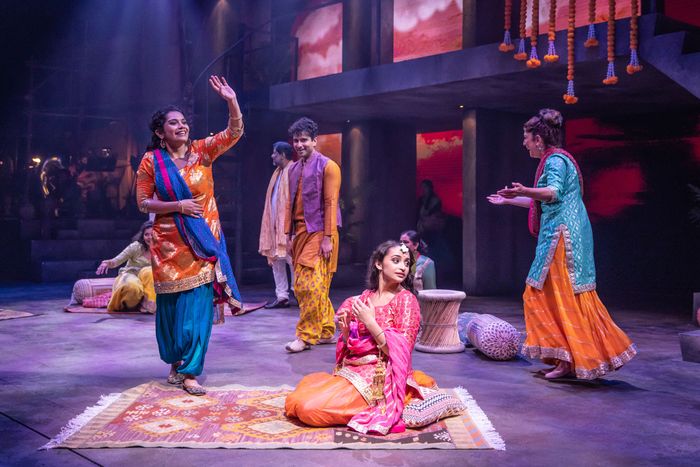
A wedding is a natural setting for a musical: You immediately have a love story to work with as well as the opportunity for subplots about family feuds, generational tensions, and more. It’s all the better if you’re looking at an extravagant event like the one in Monsoon Wedding, an arranged marriage taking place in Delhi over the course of several days, that comes with the extra stresses of class anxiety, the pressures of globalization, and the vagaries of weather. The film version of the story, directed by Mira Nair and released in 2001, even has a few diegetic musical performances, so it seems natural that, just five years later, Nair and screenwriter Sabrina Dhawan started work on turning it into a stage musical. But even after a decade of development, the version that’s made it to a stage in Brooklyn still looks and sounds like a work in progress. Nair and her collaborators have captured a lot of the energy of the film, but what seems like a natural fit for the genre ends up revealing the difficulty of making any story sing.
What works well in Monsoon Wedding are the exuberant group numbers. The show kicks off as the members of the Verma family are preparing for the arrival of the more American Rais, whose son Hemant (Deven Kolluri) is set to marry their daughter Aditi (Salena Qureshi), while their wedding planner (Namit Das, delivering his lines archly in the vein of Snagglepuss) takes a loose approach to his assignments. There’s a profusion of marigolds onstage and a band within view as well as some umbrella choreography (via Shampa Gopikrishna) indicating that you’ve arrived right in time for merrymaking. Later on, there’s some hedonistic fun when the various aunties of the extended family joke with Aditi about their sexual histories, preparing her for her future. Nair has said she was inspired by seeing Fiddler on the Roof to think of turning Monsoon into its own distinctively Indian musical about changing cultural traditions, and in scenes like that, you can see that vision most clearly. The characters, mostly all retained from the original film, play off each other well with a range of respectfulness and/or distrust toward this ceremony they’ve traveled so far to participate in. Dhawan and Arpita Mukherjee, who worked on the book for this together, have lightly updated the circumstances to the present (the bride and groom have now Zoomed before meeting in person) and kept the polyphonic dialogue where many bickering relatives talk over one another.
Monsoon Wedding, however, loses its focus when it tries to get deeper into its characters, which is where a musical needs to excel. Vishal Bhardwaj provides some tuneful melodies, but the lyrics by Susan Birkenhead and Masi Asare too often fall back on generic constructions. Hemant — now a banker who lives in Hoboken — expresses his feelings of isolation between continents with the prosaic notion that he’s “neither here nor there. I’m forever in-between.” Aditi establishes herself as a shopping-obsessed “South Delhi Girl” — “I have papa’s AmEx, and I know how to use it” — in a song that locks into one upbeat mode and stays there.
But this is a problem of structure, not just songwriting. The songs tend to idle in neutral, repeating ideas already established in dialogue, never opening up into something more. You can see this happen in many movie-to-musical adaptations where, in retaining too much fidelity toward the original, the music is treated more as an ornament than an engine of the storytelling. Compare the “play the hits” approach of something like Almost Famous to the broadening effect achieved by slowing down and expanding the perspective of the story in The Band’s Visit (where it perhaps helped that the film was unfamiliar to some audiences). The buildup to Monsoon Wedding’s intermission forces a quartet (Hemant and Aditi and the wedding planner and his love interest played by Anisha Nagarajan) that fails to bring out much underlying emotional similarity between the two couples’ predicaments. Later on, once much of the musical’s drama has been resolved, it shifts focus to a story line about an abusive uncle. On film, Nair could establish the character Ria’s discomfort in a series of close-ups during other scenes. Onstage, her solo (though well performed by Sharvari Deshpande) comes after bits of dialogue in other scenes have telegraphed her past but without grounding in the score, where it might well have developed out of a reprise of some other idea. It’s the result of starting in one genre and not considering the entirely different possibilities of the grammar of another.
It’s a frustratingly missed opportunity. I was on Monsoon Wedding’s side but was worn out by its cautiousness. It re-creates much of what’s appealing about the film and is satisfied to do so. It made me think about the plot of Monsoon Wedding itself, which is that a union that may be appealing on paper will soon come with unexpected complications — like, in this case, that the bride is still hung up on her ex. Those complications aren’t reason alone for calling off the wedding, but you have to confront them and change your expectations for it all to work.
Monsoon Wedding is at St. Ann’s Warehouse through June 25.





